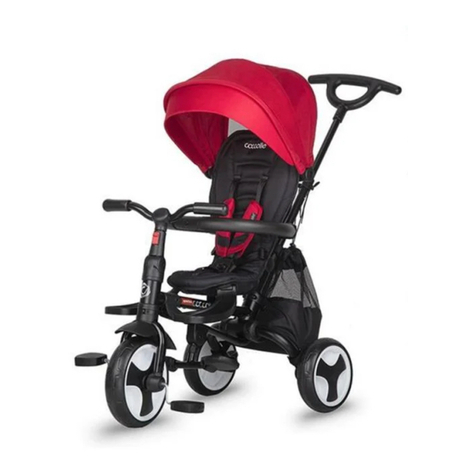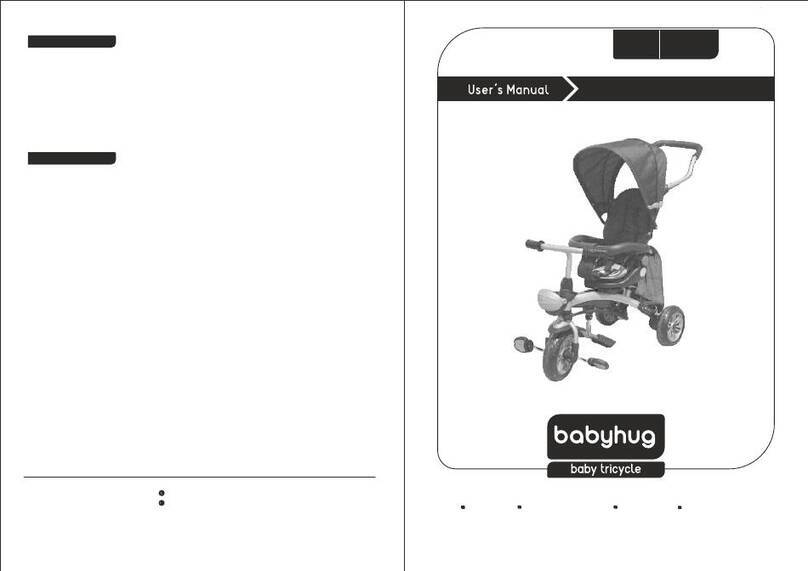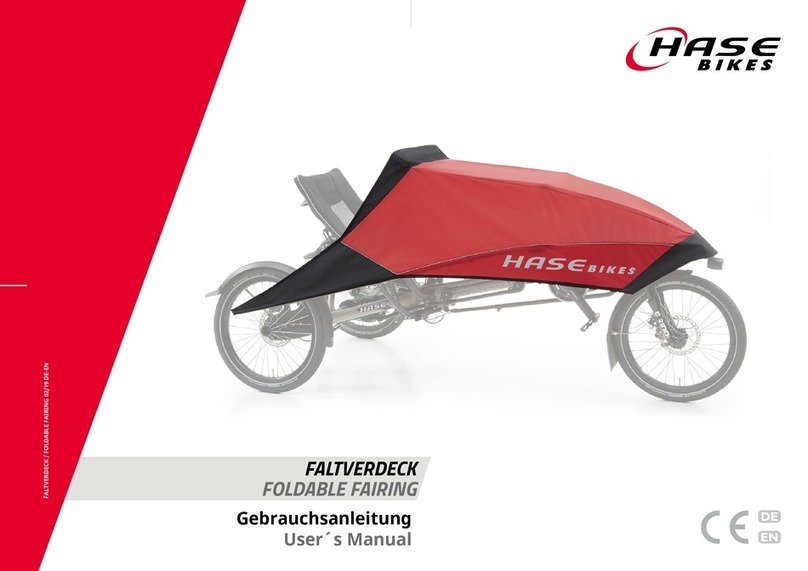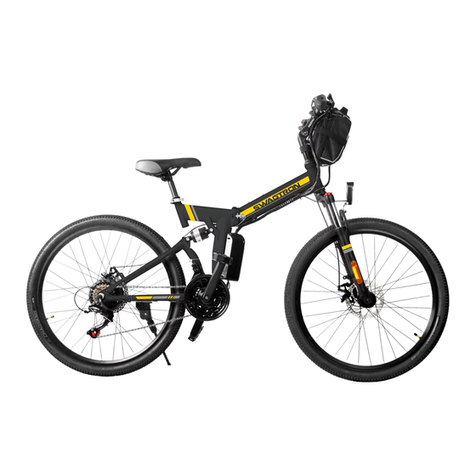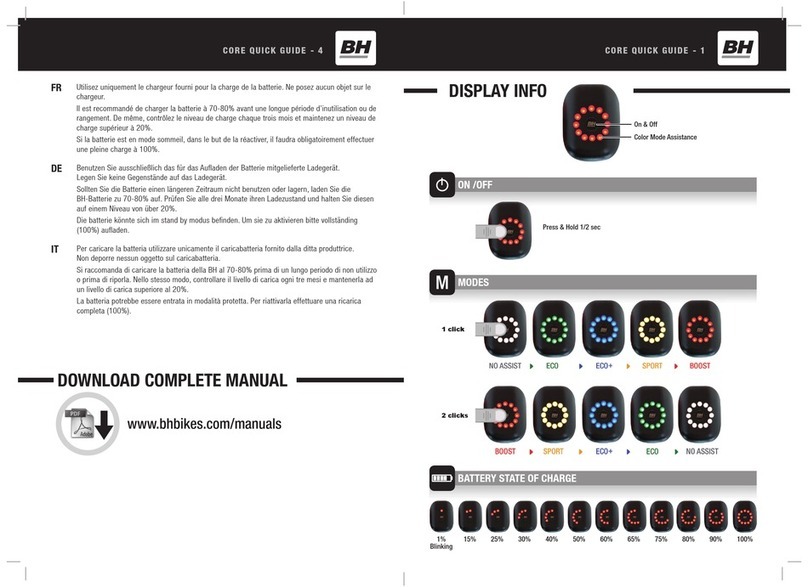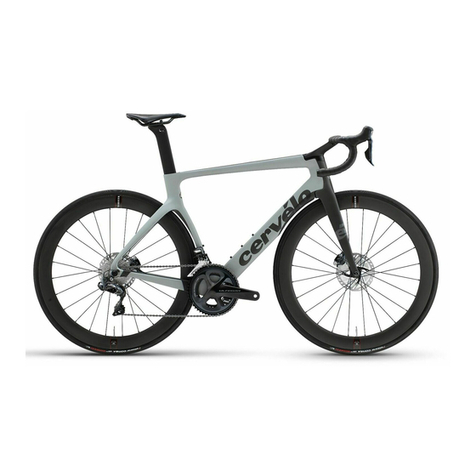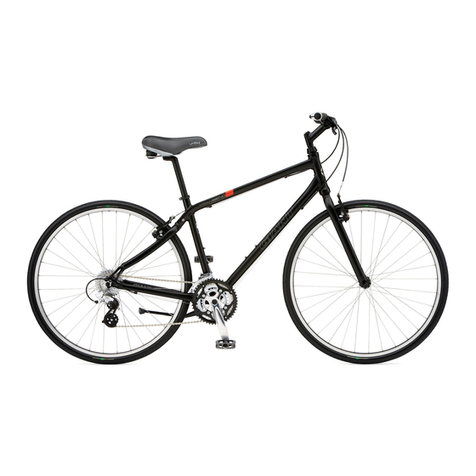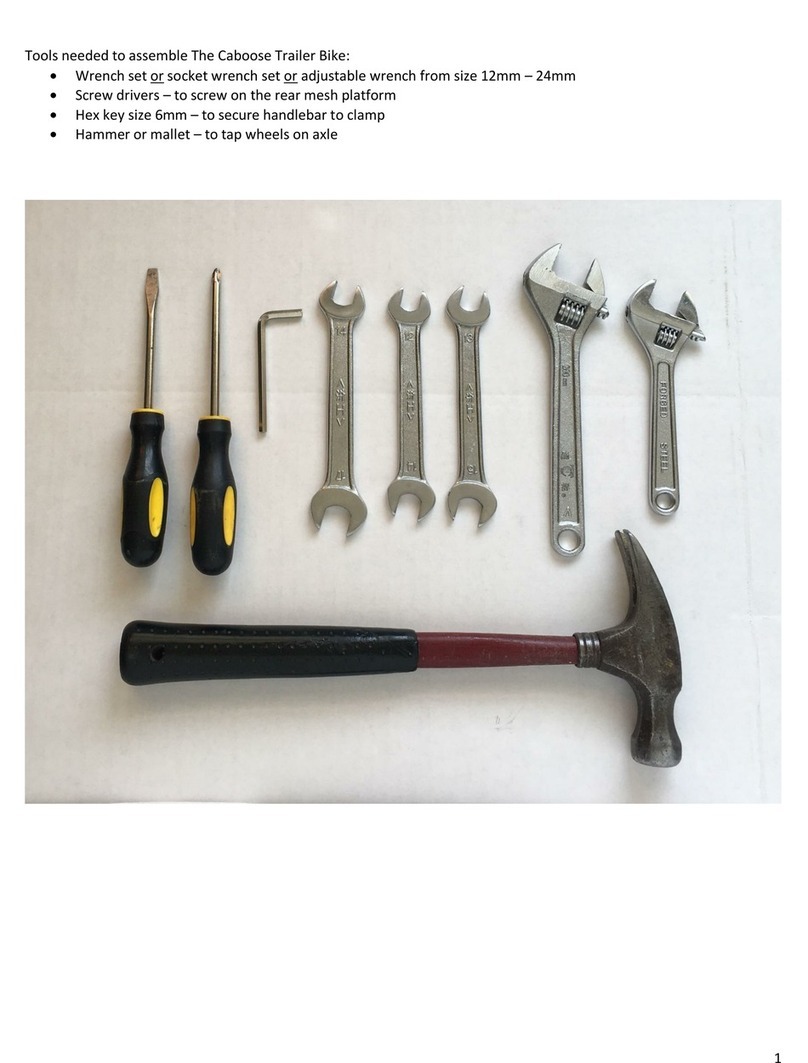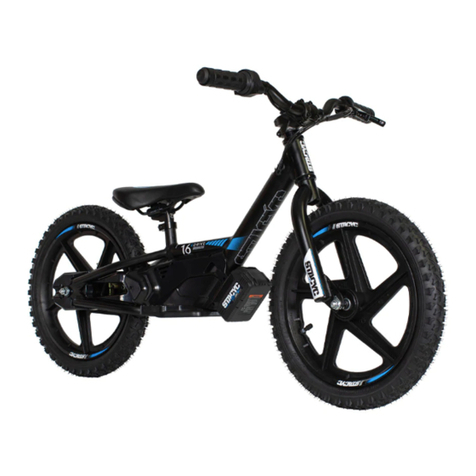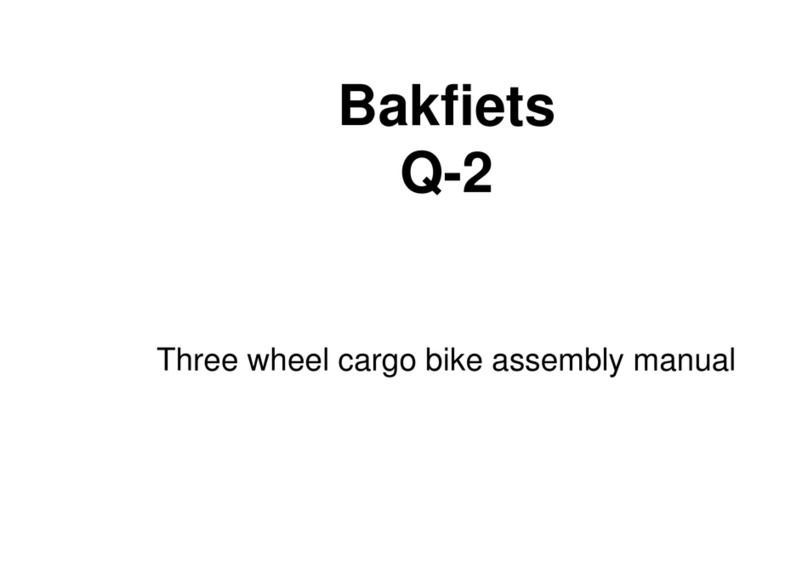WILDEWAY FW11 User manual

FW11 Electric Bike
User Manual
Please read the user manual carefully before using the product

TABLE OF CONTENTS
1 MAINTAINING YOUR BIKE --------------------------------------------------------------- 01
2 UNBOXING ----------------------------------------------------------------------------- 03
3 BATTERY--------------------------------------------------------------------------------- 08
4 OPERATING YOUR NEW EBIKE ----------------------------------------------------------- 12
5 YOUR FIRST RIDE ------------------------------------------------------------------------ 13
6 SAFETY ---------------------------------------------------------------------------------- 18
7 WARRANTY & DISCLAIMER--------------------------------------------------------------- 19

THANK YOU FOR YOUR
PURCHASE
OF A WILDEWAY EBIKE.
We appreciate your business and we hope you thoroughly enjoy
riding your new eBike.
If you need any assistance please do not hesitate to
reach out to us.
Please keep this user manual for warranty purposes
WARNING!
Read this entire manual before assembling or using your new electric bike. Do not modify,
disassemble, or replace the original electrical components on your bike. Doing so will
invalidate your warranty and could put you in danger. Riding any type of bike comes with
some risks which can’t be predicted or avoided. Taking proper care of bike components
can lower the risk of sudden failure of components but cannot prevent it. These sudden
failures could cause serious harm, injury, or death to the rider. If you notice abnormalities
in any component on the bike, take it to a licensed mechanic to be repaired or replaced
immediately. WILDEWAY Electric Technology Co.assumes no liability for harm, injury, or
death of the rider.
This manual is not intended to function as a detailed service manual. wildeway eBikes
recommends having your local bike shop mechanic perform a detailed safety check of your
bike before your first ride. Ensure your local mechanic is experienced and reputable. The
bike has an IP rating of IPX4. It does not mean that the bike and its mechanical and
electrical components are waterproof. We do not recommend storing or using the bike in
excessively wet conditions. The warranty for the WILDEWAY eBike does not cover water
damage.
For technical assistance or warranty claims contact WILDEWAY eBikes

MAINTAINING YOUR BIKE
Best Practices
• Store your bike in a clean dry place to avoid rust.
•Keep components tightened to the torque specifications listed in the Recommended
Torque Values section of this manual. Refer to the table of contents at the beginning of
this manual for the page number of this section.
• Ensure the frame latch and handlebar latch are locked in place before riding.
• Clean and lubricate moving parts regularly.
• Clean your bike frame with a wet rag and low residue cleaner. After cleaning lubricate
where necessary.
•Ensure your bike tires are always inflated to a pressure within the recommended range
printed on the tire sidewalls.
• Before each ride ensure all electrical wires are connected.
• The WILDEWAY electric bike is not waterproof. The bike has an IP rating of IPX4.
It is likely that components will not sustain damage in most rain showers, however
WILDEWAY eBikes recommends storing and riding the bike in a dry environment.
Furthermore, water damage is not covered under warranty.
• Your bike will need to be serviced at regular intervals and after the initial wear-in
period. See the 100 Mile Tune Up and Ongoing Service sections below.
100 Mile Tune Up
Your bike will need to be serviced after 100 miles or 5 full battery charge cycles, whichever
comes first. This is what we call the “wear in period” of the bike. WILDEWAY electric
bikes recommends having service done at your local bike shop by a certified and
reputable bike mechanic. Below is a summary of things to have inspected:
Brakes
Brake cables will stretch during the wear-in period. This may affect braking performance
and the brakes may need to be adjusted and tensioned properly.
Shifting
Shifting cables will stretch during the wear-in period. This may affect shifting performance
and the derailleur may need to be adjusted.
Hardware
Refer to the table of contents at the beginning of this manual for the page number of this
section. If any hardware has signs of damage take the bike to your local bike shop to have
a certified and reputable bike mechanic inspect and replace them if deemed necessary.
Ongoing Service
You should have your bike maintained at regular service intervals at your local bike shop
by a certified and reputable bike mechanic. Below is a general summary of maintenance
that should be carried out on a monthly and quarterly basis:
1

Monthly (or about every 250-500 miles)
• Inflate tires to a pressure within recommended range printed on tire sidewalls.
• Lubricate chain such that there is minimal noise from the drivetrain when in use.
• Check your bike’s shifting performance. Adjust the derailleur if necessary.
• Clean the bike with low residue cleaner and dry completely. Lubricate after
cleaning where necessary.
• Check spoke tension. Adjust if necessary.
Quarterly (or about every 750-1500 miles)
• Check all items on the Monthly service list above.
• Check tire tread for excessive wear. Replace if necessary.
• Check that electrical connectors and cable housings are secured away from moving
parts and are free from damage. Replace if necessary.
• Go into your local bike shop for a tune-up by a certified and reputable bike mechanic
2

UNBOXING
GETTING STARTED
Congratulations on your purchase of a new WILDEWAY electric bike! Your bike comes in the
box fully assembled. The instructions that follow are intended to serve as a guide in unboxing
and getting familiar with your new bike. The bike may require adjustments upon being
received and unboxed, as shipping can sometimes be bumpy.
When doing your first adjustment and inspecting the bike before riding we
recommend seeking professional help from a reputable, certified bicycle mechanic.
Electric Bike
User’s Manual
Before removing the packaging material from the bike, remove all items from the box
and make sure everything listed above is present. If anything is missing or damaged
contact wildeway eBikes immediately for assistance. For video instructions regarding
how to unfold your bike visit our youtube page: wildeway Bike.
wildeway Electric Bike User Manual
Tool Kits Battery Charger
3

Serial Number
Your bike has a one of a kind serial number associated with it. The serial number is located on
the head tube of the bike as shown in the photo below.
Please locate the serial number on your bike. You may be asked for your bike’s serial number as
a part of warranty requests.
FOLDING AND UNFOLDING THE BIKE
The wildeway electric bike folds in the center of the frame as well as at the
handlebars. Instructions for folding and unfolding the bike can be found below:
Handlebars
1. Pull the handlebar stem to its upright position.
2. Push the clasp down firmly so that it is locked in position. You should have to use
enough force such that the clasp leaves an imprint in your palm. Pull on the clasp
with your hand to confirm it is locked and the handlebars cannot fold.
3. To unlock the latch pull up on the silver button.
4. Pull the clasp while still holding the button up. You may now fold the stem.
4

Frame
1. To unfold the bike frame, grab the handlebar stem and rear end of the bike while
standing near where the battery is exposed. Lift the bike slightly off the ground and
swing the bike to its closed position.
2. Push down on the clasp firmly until it locks into position. You should have to use enough
force such that the clasp leaves an imprint in your palm. Pull on the clasp with your hand
to confirm that the clasp has locked and the frame cannot fold.
3. To unlock the bike frame and return it to the folded position, start by sliding the switch
to the right.
4. Pull the latch while still holding the switch to the position. You may now fold the bike.
Pedals
1. To fold the pedals push in slightly.
2. Continue pushing down while raising it into its folded position.
3. The pedal will click into place once in the folded position.
4. To unfold the pedals, push the pedals down until you hear an audible click as they
lock into the unfolded position.
5

PREPARING TO RIDE
•Ensure all components are properly secured before riding otherwise serious
harm or death could occur. Refer to the table of contents at the beginning of this
manual for the page number of this section. This includes but is not limited to:
pedals, handlebars, handlebar clamp, cranks, seat, and seatpost clamp.
• Make sure you can’t twist the seat or stem out of alignment by hand.
• Check to see if your saddle is positioned at the proper height. Sit on the saddle facing
forward and place the ball of your foot on the pedal at its lowest point. Your leg should
be mostly straight at this point with a slight bend at the knee. You should be able to
pedal the bike without overextending your leg when the pedal is at its lowest point.
Your legs may be overextended if it causes your hips to move side to side, which means
the seat must be lowered. To start, adjust the saddle so your feet can still be placed
firmly on the ground.
• Check your seatpost clamp and handlebar stem quick releases torque. They should
be tight enough so that they do not twist or fall down when the bike is in use.Unlatch
the quick releases and tighten by turning the bolt clockwise. Make sure both quick
releases are tightened to the torque listed in the Recommended Torque Values section
of this manual. The page number of this section can be found by referring to the table
of contents at the beginning of this manual.
• To adjust your seat up or down, unlatch the seatpost clamp. Move the seat to the
desired height and close the seatpost clamp. The open and closed positions of the
seatpost clamp are shown below(open position on right, closed position on left).
• Ensure both your seatpost and handlebar stem are inserted past their minimum insertion
points as indicated by the markings on them. Eusure your seatpost are not past the
suspension on it. These markings are shown below. Failure to insert past the minimum
insertion point will place undue stress on these components increasing the risk of
sudden failure potentially resulting in harm, injury, or death.
6

• If you need to adjust the angle of your seat or the position of the seat on the rails,
loosen the nuts on both sides of the seat, move the seat to the desired angle/position,
then tighten the nuts. The nut’s location is shown below.
• Ensure all cables and connectors at the front of the bike are securely connected
or certain components may not work including the front light, the motor inhibitor
switches, LCD display, and throttle. The motor inhibitor switches shut the motor off
as soon as the rider hits the brakes. If these switches are not operational it will
take longer to slow down which in some riding situations could cause injury
or death to the rider. If you have installed any accessories make sure they
do not interfere with all cables and connectors when turning the handlebars.
7

BATTERY
OPERATING YOUR BATTERY
Your bike comes with a 48V lithium ion battery.The location of the battery is located
underneath the saddle. Each battery has a unique set of keys that are used to turn it on/off
as well as keep it unlocked/ locked to the frame. When the battery is set on the base, the
keys can be inserted through a hole on the battery. The location of this hole can be seen
in the photo below.
The battery has 3 positions: UNLOCKED, OFF, and ON. These positions are marked on
the battery.
8

To turn on and off the battery
1. If it is not already, fully insert the battery into the battery bottom base with the keys
removed while the key position shows Unlocked. At this time, the locking pin will be
retracted.
2. Key position shown: Unlocked
Insert the keys into the battery through the hole in the bottom of the frame. At this time,
the locking pin will be retracted.
3. Key position shown: Off
Twist the keys to the position shown Off, and the locking pin will move out to protrude
through the battery track. In this position, the battery will be locked to the frame but the
power will not be active.
5. Key position shown: On
Twist the keys to the position shown On, and the locking pin will move out to protrude
through the battery track. In this position the battery will be locked to the frame, the
power will be active, and the key will be locked into the battery so it cannot be
removed. The keys must be turned to the ON position for your bike to work.
To unlock the battery and remove it from the battery base, follow the steps listed above in
reverse order. Be sure to switch the keys to Unlocked and remove the keys from the battery
before removing the battery from the bike. If the keys are still at position Off or On, it will
prevent it from being removed from the battery case.
9

KEEPING YOUR BATTERY HEALTHY
• If you know you won’t be using the battery for more than a few days, keep it charged
at about 75% capacity. At 75%, the battery will degrade less than at higher charge
levels.
• Periodically check your batteries charge level about once per month and charge back
up to 75% if necessary.
• If you want to increase the number of cycles your battery will last for, charge your
battery to 100% a few hours before you plan to ride it. For example, if you ride the bike
and the charge level falls to 50% but you plan to use the bike again in a few days, wait
until the night before you plan to use it again to charge it up to 100%. When the battery
is not in use this is healthier for the individual cells in the long term.
CHARGING YOUR BATTERY
Locate the charge port on the the battery. The battery on the WILDEWAY electric bike comes
with almost a full charge. You should plug your battery in when you first receive it to ensure
it is fully charged prior to your first ride.
• Do not leave your battery unattended while it is charging.
• The battery can be charged while attached or detached from the bike.
• Do not charge the battery with chargers other than the charger provided by
WILDEWAY eBikes.
•Only charge the battery indoors in dry spaces which are not excessively hot or cold
(Within 10°F of room temperature).
•Ensure there is no dirt, debris, or flammable items nearby when using the charger.
•The charger will automatically stop charging once the battery reaches its full capacity.
• The light on the charger will be red when the battery is charging and will turn green
when charging has finished.
• Avoid leaving the charger plugged in when the battery is fully charged.
•Do not charge the battery if you notice the battery is damaged, excessively hot, leaking,
smells, or is discolored.
•Charging the battery should take approximately 4-8 hours if the battery is mostly empty.
•Store the battery indoors in a dry space, away from heat or flame sources and out of
direct sunlight.
• The charger may get hot (>165°F) when charging. Use caution and avoid touching the
body of the charger.
10

BATTERY SAFETY
•Do not submerge the battery in liquid of any kind.
•Do not touch the terminals at the back of the battery.
•Turn off the battery when not in use and before removing from the bike.
•The battery should not be excessively difficult to attach or remove from the battery
mount. Do not force the battery to avoid the risk of damage or personal injury.
• Battery charging times may increase with battery age and usage.
• Only grab the charger by the plug and not the cable when plugging and unplugging
from the wall.
•If the battery has trouble charging, discontinue charging and contact
WILDEWAY eBikes immediately.
When your battery has worn out and is no longer usable, dispose of your battery
according to state and federal regulations. State regulations regarding battery
disposal vary so it is important you find out the rules in your state. Lithium Ion
batteries cannot be put in with normal garbage.
Lithium Ion batteries can be dangerous. Take care when using and charging your
battery. Failure to follow the above guidelines could result in damage to property
and/or serious injury. Contact WILDEWAY eBikes immediately if you have any
questions regarding battery safety.
11

OPERATING YOUR NEW EBIKE
Make sure you read this entire manual before turning on and operating your
eBike.
Now that your eBike is unfolded it is almost time to start riding. The WILDEWAY eBike is
equipped with pedal assist, a twist throttle, and can also be used as a regular bike.
To use electric assist, the battery must be charged, inserted into the battery case, and
the key must be in the battery and turned to the ON position.
COCKPIT TOUR
Before learning about how to operate your new eBike, it is important you know where
all of the important controls are located. Below are photos showing where key controls
and features are on your eBike.
Cockpit Instruments
DISPLAY
CONTROL PAD
LCD DISPLAY
SHIMANO
GEAR
SHIFTER
ELECTRIC THROTTLE
12

YOUR FIRST RIDE
To use your electric bike:
1. Read the entirety of this manual before taking your first ride.Especially the Safety,
Folding and Unfolding the Bike, Preparing to Ride, and Operating Safety sections.
The page number of these sections can be found by referring to the table of contents
at the beginning of this manual.
2. Check that the tire and the tire bead are seated just inside the rim. Inflate your bike tires
to a pressure that is within the recommended range printed on the side of the bike tire
sidewalls. When inflating, gradually inflate in 5-10PSI increments while checking to
make sure the tire bead is fully seated on the rim. If you notice the tire bead is not fully
seated at any point during inflation, deflate the tire completely and reseat the tire bead
before reinflating.
3. Check your seatpost clamp and handlebar stem quick releases. Unlatch the quick
releases and tighten by turning the bolt clockwise. The page number of this section
can be found by referring to the table of contents at the beginning of this manual.
4. Ensure both your seatpost and handlebar stem are inserted past their minimum
insertion points as indicated by the markings on them. Reference the Preparing to
Ride section of this manual for photos and complete instructions. Failure to insert
past the minimum insertion point will place undue stress on these components
increasing the risk of sudden failure potentially resulting in harm, injury, or death.
5. Check to make sure your frame folding latch and handlebar folding latch are locked.
Reference the Folding and Unfolding the Bike section of this manual for photos and
complete instructions. The page number of this section can be found by referring to
the table of contents at the beginning of this manual. Double check to make sure both
latches are secure and locked before riding. Failure to do so may result in the bike
folding while in use potentially causing serious harm to the rider.
6. Ensure your battery is fully charged before your first ride.
7. If the battery is not already placed at the battery base, slide it on the base and lock it
in position. Make sure the battery is all the way set at the base. Once the battery is
secured set, insert the key into the battery via the port on the battery. See the Battery
section of this manual for further information on the operation of the battery
13

8. Set the battery on the battery case and turn it to the ON position. You will not be able
to remove the keys from the battery in this position.
Note:
• The key has to be inside the battery and turned to the ON position in order to
operate the bike. In this position, you will not be able to remove the key from the
bike. See the Battery section of this manual for further information. The page
number of this section can be found by referring to the table of contents at the
beginning of this manual.
• Before transporting the bike on a bike rack, remove the battery from the bike.
9. Hold down the power button on the button pad located on the left handlebar until the
display comes on.
10. Select a level of pedal assist using the plus and minus buttons on the button pad.
Pedal assist level 1 is the lowest level of assist and pedal assist level 5 is the highest
level of assist. Level zero will provide no assistance.
11. Turn off the power when the eBike is not in use. This will prevent accidental motor
engagements from occurring.
12. The right handlebar features a thumb throttle. Press the throttle slowly according to
how much speed and acceleration you want to achieve. The deeper you press the
throttle 、from its resting position, the more power propels the bike forward. When the
eBike is at a complete stop, turn the display off. This will ensure that the motor will not
activate until the display is turned back on and the rider is ready to go.
( Note: Exercise extreme caution using the thumb throttle. When at a complete
stop with the bike turned on, be careful not to press the throttle unknowingly or
the bike could throw you off balance and cause serious harm, injury, or death.)
13. To turn on the headlight and tail light, press the light button on the right side of the
button pad. The battery must be inside the bike.
Use caution to not engage walk mode unknowingly. This mode is engaged by
holding the minus button on the display control pad and will engage the motor
up to a walking speed.
FRONT AND REAR LIGHTS
The WILDEWAY electric bike comes with fully integrated front and rear lights. WILDEWAY
eBikes strongly recommends using these lights when riding at night or in low visibility
situations. To turn the lights on, hold the light button on the on the right side of the
display control pad until the lights turn on. To turn the lights off, repeat.
14

WALK MODE
In general, electric bikes are heavier than their non-electric counterparts. This makes walking
the bike a more strenuous activity. To make walking the bike easier, the WILDEWAY electric
bike is equipped with walk mode. If you hold down the “ - ”button on the display control
pad, the motor will engage at a speed similar to a slow walk. When walk mode is engaged, a
“Walk”indicator will appear on the display. To deactivate walk mode, Loose the “ - ”
button. Walk mode can be toggled on or off in the settings menu. See the Display Settings
section of this manual for instructions.
OPERATING SAFETY
Before riding the bike for the first time, ensure that you have read and understood
this manual. Make sure you understand how to turn on and activate the pedal assist and
throttle. When first riding the bike, take care to start slowly in a low level of pedal assist.
Take your first ride in a safe area away from cars, other bikers, pedestrians, or other
potentially dangerous obstacles. Only move up pedal assist levels when you feel
comfortable and you have ample experience riding the bike. The higher pedal assist levels
will accelerate you to higher speeds more quickly. Take care when riding the bike at any
speed. Failure to adhere to warnings and guidelines in this manual can lead to
serious harm, injury, or death. Damage sustained by the bike from failing to follow
instructions, guidelines, and warnings in this manual is not covered under warranty.
Do not lean on the bike when it is parked and the kickstand is in use.
7 SPEED GEAR SYSTEM
The WILDEWAY electric bike comes with a 7 speed freewheel (Note: the freewheel is the
cluster of sprockets on the rear wheel of the bike).This allows the rider to maintain a
comfortable level of effort and pedaling speed throughout different terrains. For instance,
while pedaling in lowest gear (the largest sprocket), it will be easier to pedal up hills. In the
highest gear
(the smallest sprocket), the riderwill be able to reach higher speeds on flat or downhill
terrain. 1st gear is the lowest gear of this drivetrain, while 7th gear is the highest gear. Use
the thumb shifter on the right handlebar to shift gears up or down. To shift up, press the
lower button marked with the “ + ” sign. To shift down, push the lever on the top of the
shifter marked with the “ - ”sign. A photo of the shifter can be seen in the photo below.
15

Only change gears while the bike is in motion. Shifting gears at a standstill may damage
the drivetrain. Do not change gears tooquickly as doing so could cause the chain to fall off
and the rider to lose control, which could result in serious injury. If the chain falls off, turn the
bike off before fixing the chain. If you do not, and the motor turns on, you could sustain
serious injury.
DISC BRAKES
The WILDEWAY electric bike is equipped with disc brakes to ensure that you can stop quickly,
even at high speeds. The brakes are engaged by squeezing the brake levers towards the
handlebars. This pulls the brake cable, which closes the brake caliper. The brake caliper then
makes contact with the brake rotor which is attached to the bike wheels. The more you squeeze
the brake lever, the more force will be applied and thus the faster the bike will slow down. The
left brake lever activates the brake on the front wheel and the right brake lever activates the
brake on the rear wheel. The right brake lever should always be applied before and while the
front brake is also being applied. If only the front brake is applied while slowing or
stopping quickly, the rider may be ejected over the front handlebars. This could result in
serious harm, injury, or death. To avoid this, always apply even pressure to both brakes
when slowing down or stopping.
Before riding, ensure the brake lever does not touch the handlebars when fully applied.
If it does, screw or unscrew the barrel adjuster to increase tension in the brake cable. If this
does not fix the problem, take the bike to an experienced bicycle mechanic for further
adjustment.
Note: Disc brake rotors will become hot during use and will stay hot for a short period after
use. This is due to the high amount of friction between the brake pad and the rotor. Ensure
you do not touch the disc rotor right after use.
LCD DISPLAY FUNCTIONS
1
2
5
6
7
9
4
8
3
10
1. Light On/Off Indicator
2. USB Charging Indicator
3. Battery Level Indicator
4. Error Code
5. Real-time Speed Indicator
6. Speedometer in MPH or KM/H
7. Pedal assist (PAS) Level Indicator
8. Walk Mode/Cruise Control
9. Odometer, Trip, Maximum Speed
and Average Speed
10.Odometer, Trip, Maximum Speed
and Average Speed in MPH, KM/H
and Controller output current
16

1. Press the“ ”button to turn on front/rear lights. The brightness of display will
automatic lower.
2. Press“+/-”button to increase or decrease the pedal assist level(PAS). When set to higher
numbers, the motor will come on stronger. On lower numbers, it will be more gentle.
Level 0 is with no power. The default setting is Level 1.
3. Press“ i ”button to toggle Trip, Odometer, Max speed and Average speed.
4. Long press“ + ”button to enter cruise control mode. After“ ”shows on the display,
press and hold the throttle for about 8S to activate cruise control. Long press and hold
“ - ”button to activate walk mode. The bike will walk at a speed of 6km/h. Release
“ - ”button to exit the walk mode.
5. This battery indicator shows the estimated charge level left in the bike’s battery. Each bar
indicates an approximate 20% charge. The battery display will flash when there is no
charge remaining.
17
Error Code
E021
E022
E023
E024
E025
E030
Definition
Abnormal current
Handlebar failure
Default phase of motor
Hall element failure
Brake failure
Communication failure
Table of contents
